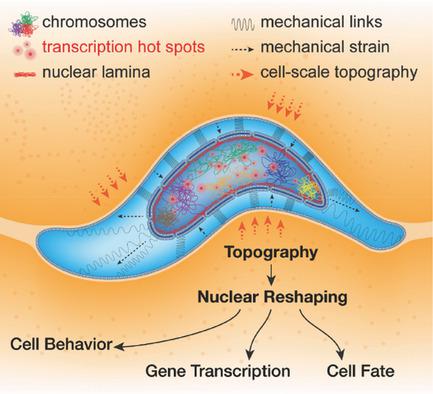当前位置:
X-MOL 学术
›
Adv. Healthcare Mater.
›
论文详情
Our official English website, www.x-mol.net, welcomes your feedback! (Note: you will need to create a separate account there.)
Role of the Nucleus as a Sensor of Cell Environment Topography
Advanced Healthcare Materials ( IF 10.0 ) Pub Date : 2017-12-28 , DOI: 10.1002/adhm.201701154 Karine Anselme 1 , Nayana Tusamda Wakhloo 1 , Pablo Rougerie 2 , Laurent Pieuchot 1
Advanced Healthcare Materials ( IF 10.0 ) Pub Date : 2017-12-28 , DOI: 10.1002/adhm.201701154 Karine Anselme 1 , Nayana Tusamda Wakhloo 1 , Pablo Rougerie 2 , Laurent Pieuchot 1
Affiliation

|
The proper integration of biophysical cues from the cell vicinity is crucial for cells to maintain homeostasis, cooperate with other cells within the tissues, and properly fulfill their biological function. It is therefore crucial to fully understand how cells integrate these extracellular signals for tissue engineering and regenerative medicine. Topography has emerged as a prominent component of the cellular microenvironment that has pleiotropic effects on cell behavior. This progress report focuses on the recent advances in the understanding of the topography sensing mechanism with a special emphasis on the role of the nucleus. Here, recent techniques developed for monitoring the nuclear mechanics are reviewed and the impact of various topographies and their consequences on nuclear organization, gene regulation, and stem cell fate is summarized. The role of the cell nucleus as a sensor of cell‐scale topography is further discussed.
中文翻译:

核作为细胞环境地形传感器的作用
来自细胞附近的生物物理线索的正确整合对于细胞维持体内稳态,与组织内的其他细胞合作并正确履行其生物学功能至关重要。因此,对于组织工程和再生医学而言,充分理解细胞如何整合这些细胞外信号至关重要。地形已成为细胞微环境的重要组成部分,对细胞行为具有多效性。该进展报告侧重于对形貌传感机制的理解的最新进展,特别着重于核的作用。这里,回顾了为监测核力学而开发的最新技术,并总结了各种地形的影响及其对核组织,基因调控和干细胞命运的影响。
更新日期:2017-12-28
中文翻译:

核作为细胞环境地形传感器的作用
来自细胞附近的生物物理线索的正确整合对于细胞维持体内稳态,与组织内的其他细胞合作并正确履行其生物学功能至关重要。因此,对于组织工程和再生医学而言,充分理解细胞如何整合这些细胞外信号至关重要。地形已成为细胞微环境的重要组成部分,对细胞行为具有多效性。该进展报告侧重于对形貌传感机制的理解的最新进展,特别着重于核的作用。这里,回顾了为监测核力学而开发的最新技术,并总结了各种地形的影响及其对核组织,基因调控和干细胞命运的影响。



























 京公网安备 11010802027423号
京公网安备 11010802027423号